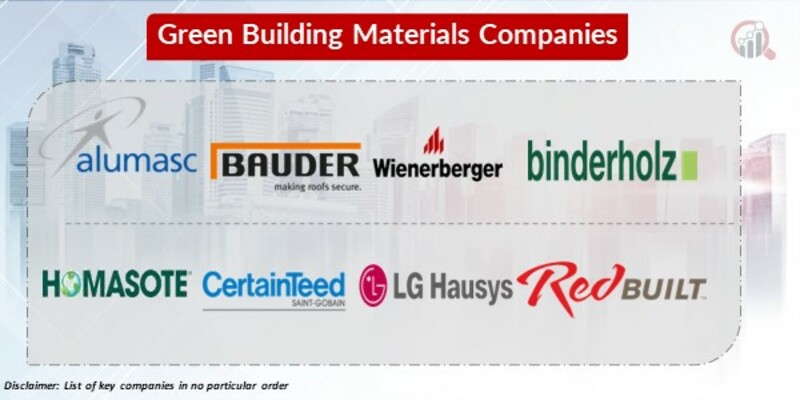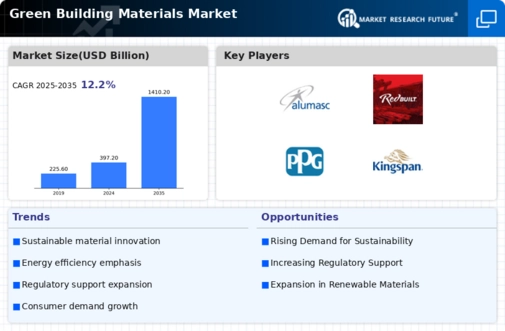Top Industry Leaders in the Green Building Materials Market

The construction industry, long a friend of concrete and steel, is undergoing a seismic shift towards sustainability.A burgeoning ecosystem where innovation and competition clash to build a greener future. From recycled plastic lumber to bio-based insulation, these eco-friendly materials are redefining the way we build, all while fostering a fierce battle for market share. Let's delve into the strategies, trends, and recent developments shaping this dynamic landscape.
Strategies Laying the Green Foundation:
-
Diversification Beyond the Basics: Leading players like Saint-Gobain and Kingspan are expanding their portfolios beyond traditional sustainable materials like recycled wood and bamboo, venturing into advanced bio-composites, carbon-neutral concrete alternatives, and even self-healing materials. This mitigates risk and capitalizes on new growth opportunities. -
Technological Twists: Innovation is the key to unlocking sustainability. Lanxess is pioneering bio-based polymers derived from agricultural waste, offering high-performance alternatives to traditional plastics in building materials. -
Circular Economy Champions: Waste not, want not. Interface, Inc. is leading the charge by developing closed-loop systems for carpet tiles, minimizing waste and maximizing resource efficiency. -
Geographic Expansion: Emerging markets like China and India present fertile ground for growth. Mahindra & Mahindra Ltd. has established production facilities in these regions to cater to the surging demand for affordable and readily available green building materials. -
Vertical Integration: Gaining control of the supply chain is crucial. Holcim Ltd. is acquiring raw material sources and investing in green manufacturing technologies, ensuring quality control, cost-effectiveness, and a competitive edge.
Factors Shaping Market Share:
-
Material Performance: Green credentials are not enough. Materials must also meet stringent performance requirements in terms of strength, durability, and fire resistance. BASF excels at tailoring its green building materials to specific application needs. -
Cost Competitiveness: Price remains a crucial factor, particularly for large-scale projects. Asian manufacturers often offer cost-effective options, while European and American players command premium prices for high-performance, innovative green building materials. Green Planet Solutions focuses on balancing affordability with sustainability. -
Regulations and Incentives: Stringent environmental regulations and government incentives for green building projects influence market dynamics. The European Union's Green Deal, for instance, promotes the use of sustainable materials in construction, boosting demand. -
Consumer Awareness: Rising environmental consciousness is driving the market. Companies like Patagonia are incorporating green building materials into their retail stores, showcasing the aesthetic and sustainable benefits, attracting eco-conscious consumers. -
Life Cycle Assessment: Understanding the environmental impact of materials throughout their lifecycle is crucial. Companies like Cradle to Cradle Products Innovation Institute are developing standardized LCA frameworks, promoting transparency and responsible sourcing.
Key Players:
-
Alumasc Group plc.
-
Bauder Ltd.
-
Wienerberger AG
-
Binderholz GmbH
-
Homasote Company
-
CertainTeed Corporation
-
LG Hausys Ltd.
-
RedBuilt LLC
-
PPG Industries, Inc.
-
E. I. du Pont de Nemours and Company
-
Forbo International SA
-
Kingspan Limited
-
Lafarge Company
-
BASF SE among others
Recent Developments :
August: Kingspan unveils a self-healing concrete composite that repairs cracks automatically, extending the lifespan of buildings and reducing maintenance costs.
September: The European Union proposes a ban on the use of certain harmful chemicals in building materials, prompting research and development into safer and more sustainable alternatives.
October: China announces a major investment in green infrastructure projects, including eco-cities and sustainable transportation networks, boosting demand for green building materials.
November: A consortium of construction companies and environmental organizations launches a research initiative to develop standardized sustainability reporting protocols for the construction industry, promoting transparency and accountability.
December: A promising startup develops a bio-based adhesive derived from algae that significantly reduces the carbon footprint of building materials, potentially revolutionizing the industry.

